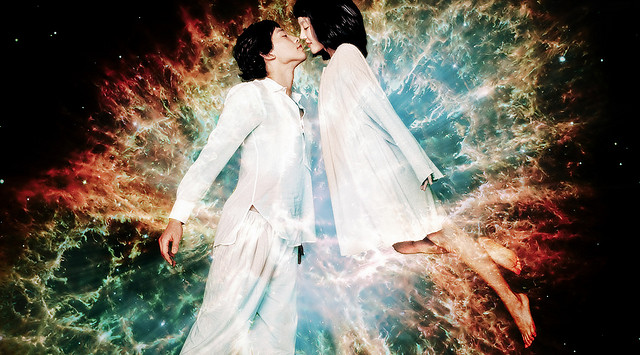
In the first article in this series, “For When We Think the Love is Gone,” we were reminded of what is still possible when the love in our relationships seems to have taken a permanent leave of absence.
We were encouraged to allow ourselves to hear the quiet whispers which remind us that the love is always present, if we can be brave enough to hear them.
These subtle whispers are there—underneath the noise of our lives and our emotions, which can bury them through fears, pain and anxiety that both our eyes and hearts have come to sense. Situations from either past relationships or our current relationship, our perceptions of our present and even our anxieties of what is to come in the future may be playing a role in our not allowing ourselves to hear these whispers.
In the first article, we explored the potential of first seeing, and then choosing with grace to love all of the aspects of ourselves that we have thought of as unworthy.
We can send love to all of those areas, and then allow our expression of love toward others to come from an overflowing of this well that we generate within ourselves.
This is not an easy task, as we live in a world (and sometimes even our own minds) which are full of judgement and comparison.
Once we find a way to love independently of the actions of others, or of a need for love, our intentions for being in a relationship can switch from that of a “need” to that of a “want.”
Somewhere in the midst of all of this though, begs the question—“Why should I want to have a partner, once I am filling myself up and feeling love for myself, independent from others?”
I believe that this is why we exist together, and much of this holds true for any relationship—with our peers, parents, or even the random encounter at the coffee shop. A partnership provides increased intimacy, and therefore, our personal growth can be increased exponentially, but first we need to find this independently so that the expression of love can flow free of our own expectations.
This is the tricky part, no? This is where the rubber meets the road. This is where we get hung up, or snagged, and prevent ourselves from seeing and sustaining the feeling of real expansive love in relationships.
But, it is in seeing this potential, and aligning with the intention behind it, where our greatest chance for sustaining a relationship and the true organic growth as a result of it, can occur.
Knowing another person soul-deep and sharing perceptions can provide another dimension to our life. If two people are looking at any object from different places, they are able to see this object through each other’s perspective as well.
Sexual interaction can also be a means to experience ecstasy of the present moment, especially when both partners are fully centered into themselves and allowing the love to arise within them first. This love can then flow out and to our partner. Sexual intimacy is the ultimate physical representation of both giving and receiving at the same time.
The more centered and present that we can be when entering into this type of encounter, the greater the potential that this can be something greater, broader and higher than ourselves, if we allow it.
Once we find this independence, this unconditional love for ourselves, we then reflect and express it to our partner.
If we can see our partner through the lens of this unconditional love, they can be more likely to see themselves this way—although we cannot force this, and this is not an expectation to which we should cling. Conversely, judging our partner and seeing or pointing out their flaws is a projection of what we actually believe about ourselves.
For example, if we see our partners as not being open emotionally, and they see us as not being open enough physically, we are both just mirroring each other. Neither of us are being fully open, but what we are each seeing are variations of the same general concept. Both can look inside themselves and dig deep as a result of what they are seeing in the other.
We can then choose to unconditionally love these parts of ourselves, which could perhaps use some healing, and this will assist us in seeing our partner in a different manner. Our responsibility in relationships is to only fully see ourselves and to make adjustments when needed. When we can adjust the lens of which we look at ourselves, and the lens from which we see our partner will adjust automatically.
If we see our partner through a lens of love, and only love, then love is all that we will feel.
It is when this lens becomes fogged, chipped, or even shattered by judgment that things can go awry. It is not our job to ever “fix” anyone.
When we do observe our partner through a lens of criticism or judgment, consider it an opportunity. As with any challenge, comes great opportunity and a strengthening of ourselves. It is through the challenges of relationship that we can more deeply see ourselves and what we are, and also what it is that we are trying to do, be, feel and create.
What, in this moment can I learn?
What, in this moment can I see in myself through what I have just somehow seen in them?
It is crucial not to judge yourself when you see yourself judging your partner. Rather, this self-awareness is an opportunity to practice grace and unconditional love for ourselves and even to love ourselves more fully through this process.
We can choose to steer ourselves in a slightly different path, and we can do this with fluidity and resisting the propensity to become snagged or stuck on what we are seeing.
We can approach these matters with curiosity, rather than judgment.
It is all just part of the growing process, and while we and our partner are growing together, it is not our job to monitor, guide, assess or compare what we are doing to what our partner is doing—in doing so, we can come out of our independent love-state and things can become unhinged. If this happens (and it likely will), that is okay.
We can let it go and come back to the original intention of feeling nothing but the love that, on some level, we all know is there.
The opportunity for commitment in a relationship or partnership is not a contract. With a contractual arrangement comes expectations, rather the commitment comes from an independent desire to see, feel and be love.
Any projected expectations that we stick onto our partner just make our love for them conditional, and true love is not conditional or situational, it is seeing and accepting that perfect part of them underneath the layers.
It is during the times when we are capable of fully loving ourselves that we can choose to be a conduit of that love to our partner. If we are judging ourselves and seeing ourselves as flawed, we will be much more likely to see our partner this way as well.
Looking into the eyes of our partner, for just a moment or longer, can be a reminder of who they really are aside from actions, words, or anything else that we have come to believe and see as flawed. Eye contact can be one of the most effective reminders of the connectedness that is always there, underneath all of the confusion of our inner and outer worlds.
Each challenge or conflict in a relationship comes with it the opportunity for even more freedom and independence, if we choose to see the dynamic through this perspective. We can put ourselves in a state of awareness, which is above whatever has tripped us up before.
These pivotal moments are always possible—if we can choose to be accountable for the way that we feel, and not expect them to make us feel differently.
The pure joy that we feel in relationships can be that of freedom, because it is not contingent on anything other than ourselves. Nobody can touch, take away or affect the love that we feel for ourselves, unless we allow this. It is completely our choice and when we choose this, we also choose to be accountable for our own feelings.
This joy that we feel is nothing but a result of the love that we are allowing to flow freely through us—not the expectation of love to flow to us from our partner, as many of us have become conditioned to believe.
This is real freedom; this unconditional love can be sustained—it is always available to us. With it comes an endless sea of opportunity for more, in which we can go deeper and swim even more freely, together.
Relephant Read:
How to Love Me: A Step by Step Guide.
Author: Katie Vessel
Editor: Catherine Monkman
Photo: akshay moon/Flickr










Read 0 comments and reply